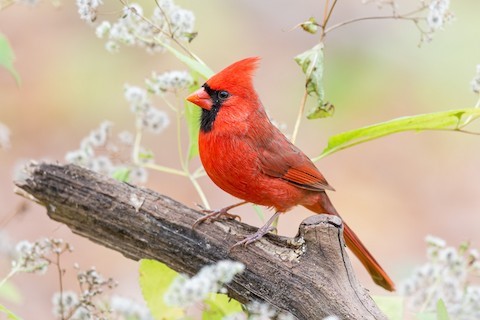Cardinalidae: Cardinals

Northern Cardinal. © Mark Kraus
The cardinals are a recently defined family of New World songbirds, named for its best-known member, the Northern Cardinal (Cardinalis cardinalis) of North America. Cardinals are visually diverse and do not appear to share any distinctive family trait. The membership of the Cardinalidae, as determined through genetic studies of relatedness, includes several of North America’s most colorful birds which were formerly classified in different families, such as the Scarlet and Summer Tanagers (Piranga olivacea and rubra), Rose-breasted Grosbeak (Pheucticus ludovicianus), Dickcissel (Spiza americana), and Indigo and Painted Buntings (Passerina cyanea and ciris).
The family is widespread in the Americas, with a few species that breed north into the boreal forest zone of Canada and a few that reside south into Argentina. But the family reaches its peak diversity in Middle America—over half of its species occur in Mexico.
Taxonomy
The Cardinalidae with its current membership results from a comprehensive reclassification of nine-primaried songbirds that is primarily based on robust genetic research. The classification of cardinals as a family is also supported by commonalities in skull anatomy, which seems to indicate high confidence in it and accordingly high probability that it will remain intact through future waves of taxonomic reconsideration.
The biggest lingering question in the cardinals’ taxonomic future appears to be their status as either an independent family or a subfamily of the closely related Thraupidae—the traditional “tanager” family which has been revised to include a wide array of seedeating birds formerly classified in various finch families. Much like the Thraupidae, the Cardinalidae are also a mix of former tanagers and former finches. It would not be surprising if that basic commonality and their close phylogenetic affiliation eventually lead to a new consensus that the cardinals are best regarded as a subfamily of thraupids.
The species-level taxonomy of the cardinals is stable across most of the family, but a few branches have open issues. In particular, the Habia ant-tanagers and Granatellus chats are poorly understood, and two blue seedeater forms in western Mexico have each been regarded as either separate species or as western subspecies of more widespread species. The total count is in the range of approximately 55 to 66 species.
Red-throated Ant-Tanager (Habia fuscicauda)
“Salvin’s Ant-Tanager” (H. f. salvini)
“Red-throated Ant-Tanager” (H. f. fuscicauda)
Black-cheeked Ant-Tanager (Habia atrimaxillaris)
Sooty Ant-Tanager (Habia gutturalis)
Crested Ant-Tanager (Habia cristata)
Red-crowned Ant-Tanager (Habia rubica)
“Red-crowned Ant-Tanager” (H. r. rubicoides)
“Scarlet-throated Ant-Tanager” (H. r. rubra)
“Brazilian Ant-Tanager” (H. r. rubica)
Ochre-breasted Tanager (Chlorothraupis stolzmanni)
Lemon-spectacled Tanager (Chlorothraupis olivacea)
Carmiol’s Tanager (Chlorothraupis carmioli)
Olive Tanager (Chlorothraupis frenata)
Red-headed Tanager (Piranga erythrocephala)
White-winged Tanager (Piranga leucoptera)
Red-hooded Tanager (Piranga rubriceps)
Rose-throated Tanager (Piranga roseogularis)
Scarlet Tanager (Piranga olivacea)
Western Tanager (Piranga ludoviciana)
Flame-colored Tanager (Piranga bidentata)
Summer Tanager (Piranga rubra)
Hepatic Tanager (Piranga hepatica)
Tooth-billed Tanager (Piranga lutea)
Blood-red Tanager (Piranga haemalea)
Red Tanager (Piranga flava)
Northern Cardinal (Cardinalis cardinalis)
“Northern Cardinal” (C. c. cardinalis)
“Long-crested Cardinal” (C. c. carneus)
Vermilion Cardinal (Cardinalis phoeniceus)
Pyrrhuloxia (Cardinalis sinuatus)
Black-faced Grosbeak (Caryothraustes poliogaster)
Yellow-green Grosbeak (Caryothraustes canadensis)
Crimson-collared Grosbeak (Rhodothraupis celaeno)
Red-and-black Grosbeak (Periporphyrus erythromelas)
Black-headed Grosbeak (Pheucticus melanocephalus)
Rose-breasted Grosbeak (Pheucticus ludovicianus)
Orange Grosbeak (Pheucticus aurantiacus)
Yellow Grosbeak (Pheucticus chrysopeplus)
Black-thighed Grosbeak (Pheucticus tibialis)
Golden Grosbeak (Pheucticus chrysogaster)
Black-backed Grosbeak (Pheucticus aureoventris)
“Mérida Grosbeak” (P. a. meridensis)
“Yellow-throated Grosbeak” (P. a. crissalis)
“Yellow-rumped Grosbeak” (P. a. uropygialis)
“Black-backed Grosbeak” (P. a. aureoventris)
Red-breasted Chat (Granatellus venustus)
“Red-breasted Chat” (G. v. venustus)
“Trés Marías Chat” (G. v. francescae)
Gray-throated Chat (Granatellus sallaei)
Rose-breasted Chat (Granatellus pelzelni)
“Rose-breasted Chat” (G. p. pelzelni)
“Rose-bellied Chat” (G. p. paraensis)
Dickcissel (Spiza americana)
Cabanis’s Seedeater (Amaurospiza concolor)
“Slate-blue Seedeater” (A. c. relicta)
“Blue Seedeater” (A. c. concolor)
Ecuadorian Seedeater (Amaurospiza aequatorialis)
Carrizal Seedeater (Amaurospiza carrizalensis)
Blackish-blue Seedeater (Amaurospiza moesta)
Glaucous-blue Grosbeak (Cyanoloxia glaucocaerulea)
Blue-black Grosbeak (Cyanoloxia cyanoides)
Rothschild’s Grosbeak (Cyanoloxia rothschildii)
Ultramarine Grosbeak (Cyanoloxia brissonii)
Blue Bunting (Passerina parellina)
“Turquoise-fronted Bunting” (P. p. indigotica)
“Blue Bunting” (P. p. parellina)
Blue Grosbeak (Passerina caerulea)
Indigo Bunting (Passerina cyanea)
Lazuli Bunting (Passerina amoena)
Rose-bellied Bunting (Passerina rositae)
Orange-breasted Bunting (Passerina leclancherii)
Varied Bunting (Passerina versicolor)
Painted Bunting (Passerina ciris)
References
Boyd, J.H., 2019. Taxonomy in Flux: Core Passeroidea V: Mitrospingidae, Cardinalidae, Thraupidae. http://jboyd.net/Taxo/List32.html. (Posted August 2, 2019. Accessed April 18, 2021.)
Roberson, D. 2009. Bird Families of the World: Cardinals, Grosbeaks & Allies: Cardinalidae, http://creagrus.home.montereybay.com/cardinals_grosbeaks.html. (Posted July 12, 2009. Accessed April 18, 2021.)